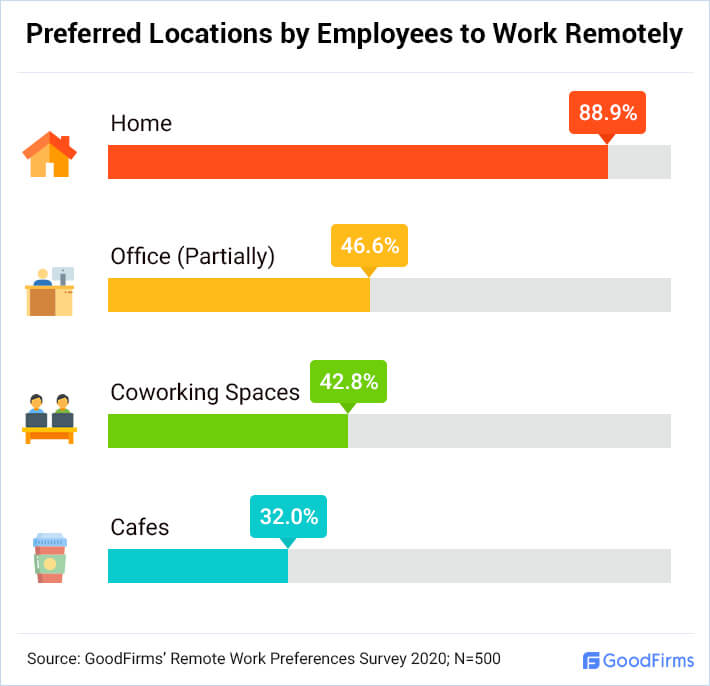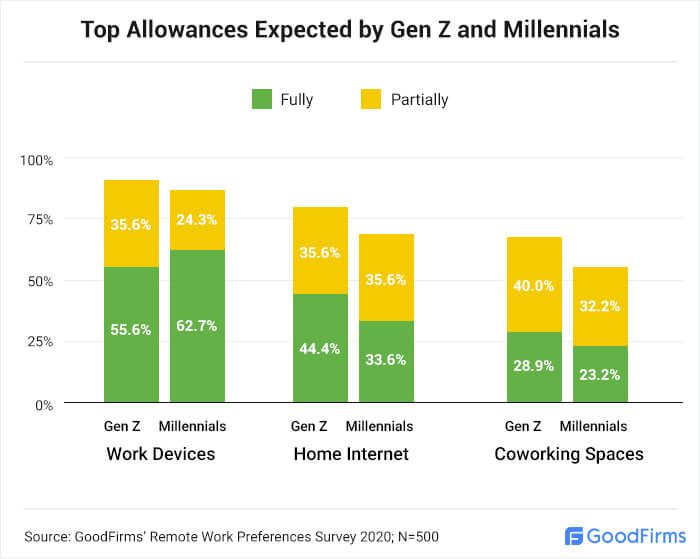The COVID 19 pandemic forced everyone to shift to remote working. While some companies were doing it even before the pandemic, it became more of compulsion after it. GoodFirms surveyed 500 professionals across the world to know their preferred locations for remote work, the kind of allowances they expect from their employer, and the right frequency of team meetings in remote work to maintain productivity.
For a majority of the businesses, completely working remotely was still a new concept and they struggled with adjusting to the new normal. The concept of remote working has majorly proved to be advantageous in multiple ways but it is yet to be determined what the future holds for workplaces across the globe.
Usually, employees get certain allowances when they are working from the office. But as the work scenario changed, their needs changed; thus their allowances too. It can range from day to day necessities to healthcare or setting up the office at home.
Furthermore, once the work is streamlined, there is a need to ensure seamless communication too. Just like all other things, the frequency and duration of team meetings also underwent a change in the pandemic.
Especially during these times, it is crucial for employers to take care of the well being of their employees. The GoodFirms research attempts to get insights into what working models are preferred by the employees. Not only that but the research also contains data about the employees’ choice of various remote working locations and allowances.
Employers and HR professionals can use this report to understand the employees’ preferences on remote working and different locations for the same. Moreover, they can also get insights into what kind of compensation employees expect while working remotely. All these stats will help employers and their partner HR outsourcing services to create an optimum remote working environment and retain their employees for the long term.
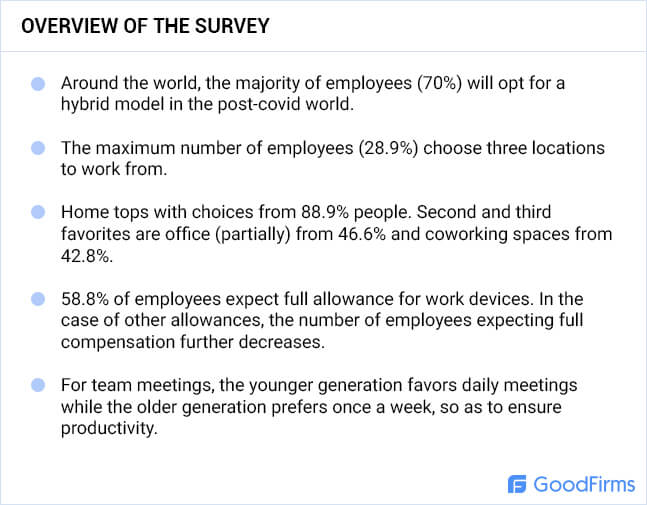
A Majority of People Will Prefer Hybrid Model Post-Covid
COVID - 19 has altered the choices of people in multiple ways. One of them is their preferred working model, once things go back to normal. So, the participants were asked about their choice of the working model for their permanent job. The stats of whether they would want office only, remote only or hybrid model are as follows:
A majority (70%) of the participants opted for a hybrid model.

One of the primary reasons for the popularity of the hybrid model is that the employees get to choose their preferred location of working as well as set up a comfortable remote office which ensures productivity too. They have a structure of working but at the same time get independence and flexibility to complete their tasks.
An interesting trend that emerged out of the survey is that a substantial number of millennials (72.9%) will opt for the hybrid model. The trend is consistent with other generations - Gen Z, Gen X, and Baby Boomers too. But there is a slight difference in the numbers.
Initially, the remote working move was a compulsion due to the circumstances. As the work from home fatigue kicked in, more employees started seeking out a more balanced approach to working. This is where the hybrid model became a favorite as they can choose to work from the office or any other remote location as per their individual circumstances.
Adam Fingerman, the CEO of ArcTouch, briefly states the reason for the hybrid model to be a practical and beneficial choice in the coming years. In his words, “I believe a hybrid model of some in-person work and some remote work makes the most sense for the long run. It provides opportunities for face to face collaboration and connection building regularly but also gives employees the flexibility of working from home when they need it. A model like this is the best of both worlds for employers and employees, and may also help balance the overcrowding and traffic woes that many large metro areas are faced with from commuters.”
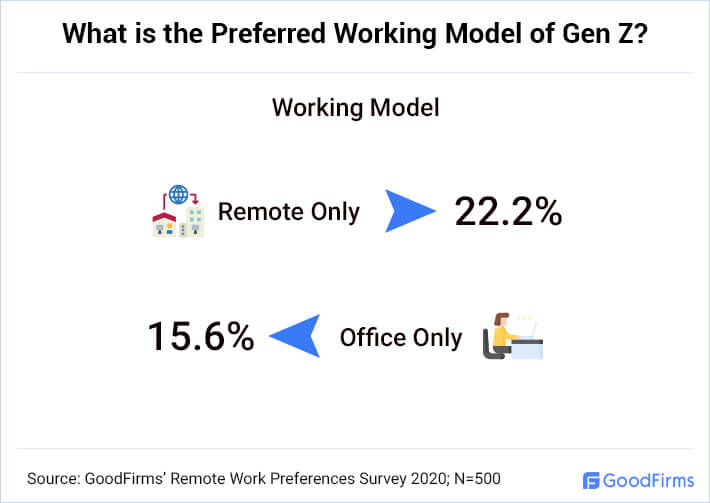
Only a minor number of employees are in the favor of either remote only or office only working models.
Home & Office (Partially): Top Choices of Remote Employees to Work From
The whole point of employees favoring remote working is that they can work comfortably in the location of their choice. However, the number of remote locations that an employee chooses can vary.
To get insights into the remote locations, the respondents were asked their preferred locations. 28.5% of them preferred a single location, 22.1% of them mentioned two remote working locations, and the highest number (28.9%) was for three remote working locations.
Furthermore, out of all the remote locations, home (88.9%) tops the list. The next in line comes the office (partially), co-working spaces, and cafes. Apart from home, other locations are necessary because even an introverted person will get tired of being in the same place. Surrounding themselves with new places and people can help to remain motivated and productive at work.
The Marketing Manager at Incrementors, Brack Nelson, is in favor of home as an ideal place for remote working and briefly states the reason too. He says, “I would work remotely from home because at home you have the freedom to decorate your own workspace; the flexibility to switch between work and personal tasks; save costs on eating out; reliable Internet connectivity; substantial privacy; no commute. I will stay in contact with the team as much as I can and I’ll make sure I get the network without any issue.”
Working from the office (partially) ranks second in the list with 46.6% of employees choosing that as an option. Out of all the generations, half of the millennials (51%) would want to go to the office sometimes while they are working remotely.
Christine Glossop highlights the importance of working from the office (partially) even when the team is working remotely. A team will always need someplace to bond and maintain that socializing factor. She said, “Even in a mostly remote company, having a place that employees can use for meetings or gatherings will still be important—even if it's not the center of work anymore. Occasionally working from the office will be an important part of maintaining connection and collaboration with my coworkers in a mostly-remote working environment.” Christine is the SEO Manager at Looka.
Coworking Spaces: A Favorite of the Younger Generation
Home, as a remote working location, has topped the list but it cannot be a convenient option for everyone. There are chances that remote workers get bored or frustrated working at the same place. Adding to this feeling is the fact that there is no way for them to socially interact with other people. Coworking spaces can offer both - a new environment to work in as well as an opportunity to connect with other people.
The concept of coworking spaces existed before the pandemic too. But the coworking spaces may become more important and necessary after the crisis. It is already visible in the fact that coworking spaces rank third in the options for working remotely.

A substantial number of employees (42.8%) will want to work at coworking spaces. One of the primary reasons coworking spaces are becoming popular is because they don’t just offer space, they are a complete solution. Coworking spaces give unique experiences by offering state of the art amenities like gyms and cafes. Moreover, after months of working at home, employees would want a change of place for working.
If the preferences of the younger generation are taken into consideration then a substantial number of Gen Z (52.6%) and millennial (46.1%) employees are favoring a coworking space. As the younger generation will slowly constitute the majority of the workforce in an organization, these statistics offer some insights into their choices.
Another major reason for the popularity of coworking spaces among the younger generation is that they represent their ideologies. They can work at the time most convenient for them as co-working spaces generally allow 24/7 access. Furthermore, these spaces offer a whole lot of other facilities like the freedom to bring a pet along, round the clock internet and IT support, in-house coffee stations, big screens to watch Netflix/sports, etc.
Hence, coworking spaces are turning out to be a popular choice among the employees.
Most Expected Allowances by Remote Employees
Employees expect allowances from their employers irrespective of whether they work from the office or home. The only difference between the two situations is the type of allowances expected and whether the allowances should be fully or partially paid. There is also a possibility that some employees may not want any sort of allowances.
Thus, the participants were given options of different types of allowances like work devices, home internet, coworking membership, furniture, and food/drinks. Furthermore, they were also asked if the allowances are required to be fully/partially paid or they don’t need anything.

-
Work Devices
Work devices are a basic requirement of remote working. When the employees were suddenly shifted to a remote work setup, many of them did not have laptops or other necessary equipment to seamlessly finish their daily tasks. So, it became almost inevitable for organizations to provide the necessary technological infrastructure. So, when asked about allowances for work devices, a significant number of employees (58.8%) are expecting a fully paid work devices allowance.
-
Home Internet
Again, one of the absolutely necessary things for remote working. The home internet allowance is essential because, in some of the cities/states, a stable internet connection is not available easily. Apart from that internet usage also increases while working from home. As a result, 33.6% of employees want a full allowance for home internet.
-
Coworking Membership
Coworking spaces are slowly gaining momentum among the younger generation. Some of the common benefits of a coworking space are in-office perks, increased flexibility, convenient location, and an increased sense of community. Taking into account all these advantages, a small number of surveyed employees (23.2%) want a full allowance for the same.
-
Home Office Furniture
When it comes to home office furniture allowance, it is not necessary that every employee will need it. There are chances that some employees had a comfortable working space at home even before COVID, while some set it up after the pandemic. Whatever the scenario may be, only 12% of the participants want a complete allowance for home office furniture.
-
Food/Drinks
Remote working is not limited to work from home. It also means work at home. In the current scenario, being at home means additional responsibilities for the employees. It becomes more of a task for the ones living alone as otherwise, they would get their meals from the office’s cafeteria. So, companies can offer a meal allowance. Despite this allowance being one of the latest additions to the list, a minor number of employees (11.6%) were expecting a full allowance for their food/drinks.
Of-Course, Different Generations Wants Different Allowances
It is perfectly normal for employees to expect some kind of allowance while working remotely. In office, employees usually get the devices/equipment they need for completing the project on hand. But that may not necessarily be the case with remote working. Moreover, every generation of employees will have different priorities and that is reflected in the types of allowances they will expect from their employers. The preferences of millennials are bound to differ from that of Gen Z or Gen X.
To understand the take of different age groups of employees on different allowances, they were asked if they need the allowance completely, partially, or nothing. The stats of the participating workforce are as follows:
-
Work Devices
Remote workers expect to get the same allowances as the traditional teams irrespective of the generation. An allowance for work devices is one of them. Needless to say, work devices are a primary requirement for seamless remote working. Apart from the common work devices like laptops/PC, some professions may require additional devices too.
Therefore, a noteworthy number of Gen Z employees (55.6%) expect a full allowance from their employers for work devices.
Angela Hope, a Digital Marketing Specialist at UpFlip says something on a similar note. In her opinion, “While most remote workers should already have a computer, if something specific is needed for a specific project or task (that was not mentioned as a requirement at the time of hire or when moving over to remote work), the employer should provide it. A good motto to go by is that if the supplies, software, or equipment required are not part of your initial agreement or your regular tasks, then an allowance should, in good faith, be offered.”
In the case of millennials, a great number (62.7%) of them too expect fully paid compensation for their work devices.
Agreeing with the millennials’ need for work devices allowance, is the HR Manager of ResumeLab. Jagoda Wieczorek said, “One of the best ways to support remote Millennial employees is to introduce a one-time equipment purchase program. In essence, it’ll help Millennials get something they believe will help enhance their productivity while working from home. It could be a business headset, a second monitor, a webcam, or an ergonomic chair.”
-
Home Internet
Today, almost everyone has a home internet connection. Home internet is also something that no remote worker can compromise on. But its usage will definitely change to a certain extent once the employees shift to a remote work setup. Of course, it also depends on the type of work they do. Also, as they are not using office resources anymore, they may expect the employers to help them with their internet expenses.
Keeping the variable factors aside, a considerable amount of Gen Z employees (44.4%) want a complete allowance for their home internet connection.
An Outreach Consultant at Gigworker, Omair Khan, explains how home internet is used more while working remotely as compared to employees working from an office. Omair said, “With the remote working scenario, there is an excess amount of internet usage to meet the needs of daily work. This, when coupled with the normal internet usage that one might have during the off-hours; can actually add up to a fair bit of data usage. As a result, it is important that remote workers be provided compensation/ an allowance for internet usage to ensure that they don’t have to worry about the extra data usage.”
When millennials were given the options to choose from a full, partial, or no allowance for home internet, there is not much of a difference between the statistics.
About 35.6% of millennial employees expect only a partial allowance for their home internet.
-
Coworking Spaces
In the past few years, coworking spaces have gained huge popularity among the employees. After the pandemic, there is a possibility that the coworking spaces see growth. As Gen Z is the youngest of all generations of employees, their opinion on an allowance for coworking membership also varies.
Out of all the generations, Gen Z voted the highest (40%) for wanting a partial allowance for their coworking membership.
According to research, millennials form about 65% of the coworking member base around the world. Having said that, millennials have quite a difference of opinion in choosing between full, partial, or no allowance for the same.
The trend for coworking membership allowance in millennials shows that a small number (23.2%) of them want a fully paid allowance for their coworking membership.
Daily Team Meetings Deemed Necessary to Ensure Productivity
It is inevitable that the practical implementation of team meetings will be different in office only scenario and remote working scenario. There are chances that while employees are working remotely, their preferred frequency of team meetings will change.
Hence, the surveyed employees were asked the question, “How many team meetings are sufficient to ensure productivity in remote working?”. The statistics of their responses are as follows:
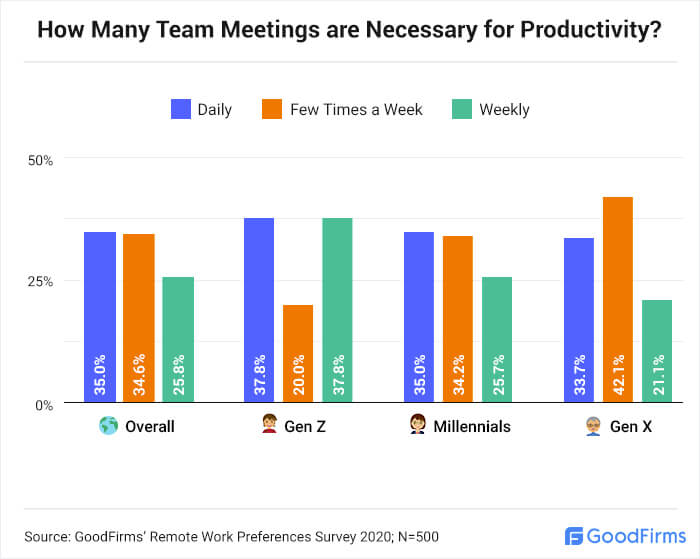
The highest number of respondents (35%) voted for daily team meetings to ensure that productivity is maintained. The trend of wanting regular team meetings is consistent with the younger generations i.e Gen Z and millennials.
37.8% of Gen Z thinks that daily meetings are a necessity for remote working employees. Keeping up with these statistics are the millennials with 35% votes for daily meetings.
Karen Gordon from Goodshuffle Pro gives a valid explanation for conducting daily team meetings. The VP of Growth mentions, “Daily team meetings help us do three things: It maintains team comradery. As I believe many of us are now well aware of, remote work can feel quite isolating. By hopping on a quick video chat every day, typically no longer than thirty minutes, we are reminded that we are not alone in this. A daily meeting helps us get into work mode when we are “forced” to look at each other and talk about work things.”
34.6% of the survey participants think that team meetings held a few times a week should be enough while remote working. A notable number (42.1%) of Gen X employees prefer team meetings that are held a few times a week.
Kelsey Chan, a Marketing Specialist, is of the opinion that team meetings held twice a week will ensure that the work is going as per the pre-decided timeline. CocoSign Inc’s marketing specialist said, “While managing the remote working team, the frequency of holding meetings should be twice a week. In order to ensure employees' productivity, the first meeting that is held will talk about the work that should be done within this week while the second meeting will see how the progress of the work so far and how is employees’ performance.”
There are also 25.8% of employees who think a weekly meeting will do the needful.
John Ross from Test Prep Insight agrees with the employees’ opinion that weekly meetings are enough for maintaining the required productivity level. The President & CEO said, “In my experience, the perfect frequency for team meetings is once per week. I have tried experimenting with more and less frequent meetings since the pandemic started, but have experienced the effects mentioned above. A once-weekly meeting seems to do the job, and based on our productivity metrics, has had the highest impact on our team's output.”
In the case of less frequent team meetings, the numbers vary to a great extent from the previous choices. Only 1.4% of the total employees voted for fortnightly team meetings, the same goes for a few times a month meetings. Lastly, 1.8% are of the opinion that monthly meetings will make sure that the employees remain productive in the remote work setup.
Conclusion
Remote working initially sounded convenient for everyone. But as the time to remain at home is getting prolonged due to the pandemic, most employees are eager to give the hybrid working model a chance in the near future. As compared to the hybrid model, there are a lesser number of employees who are in favor of either remote only or office only working models.
In terms of the types of allowances like work devices, home office furniture, home internet connection, coworking membership, and food/drinks that the employees expect during remote working, the surveyed generation of employees have different expectations. Even within the same generation of employees, it can be seen that they prefer full allowance for some things and would want nothing for the other allowances on the list.
About The GoodFirms’s Remote Working Survey
GoodFirms surveyed 500+ working professionals to know their opinion on remote working and its related aspects.
The survey participants are mainly males (71.4%), followed by females (27.8%). The participants belong to the ages: 18 - 24 (9%), 25-39 (70.8%), 40-59 (19%), and 60+ (1.2%).
Respondents are from the United States (23.2%), United Kingdom (14%), Australia (13%), Canada (20%), India (13.8%), and Others (16%).
The participants were asked questions about their choice of the working model after things resume to normal such as their preferred locations for remote working, what type of allowances do they need to make their remote working setup comfortable, and whether they will like a full, partial, or no compensation at all.
We humbly thank our Research Partners, who helped us garner survey participants and contributed significant insights for this research.
* For any queries, drop an email to [email protected]
AppsWise Technologies Pvt. Ltd
Archybility Software Developme
Axodus Infotech Private Limited
BDSD Technology Private Limited
Clecotech International Pvt Ltd
CruzataSoft Cloud Private Limited
LO Technology Services Pvt. Ltd
Memorres Digital Private Limited
Pioneers IT & Business Consulting
Pixus Technology & software Firm
Pure Innovation Business Solutions
Softclain Technologies Private
The Distance | UK App developers
The Stakeholder Management Group
The Story Web Design & Marketing
Think Little Big Marketing Ltd
Transfunnel Consulting Pvt Ltd
V2STech Solutions Private Limited
